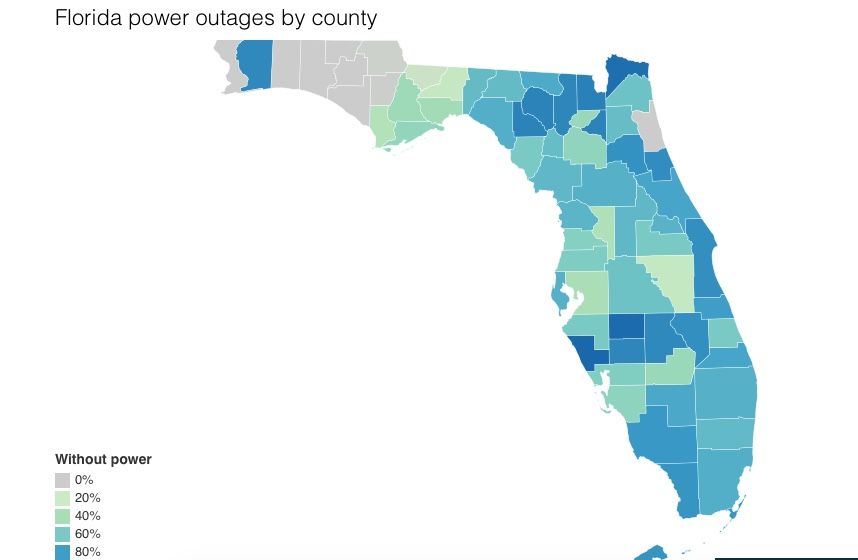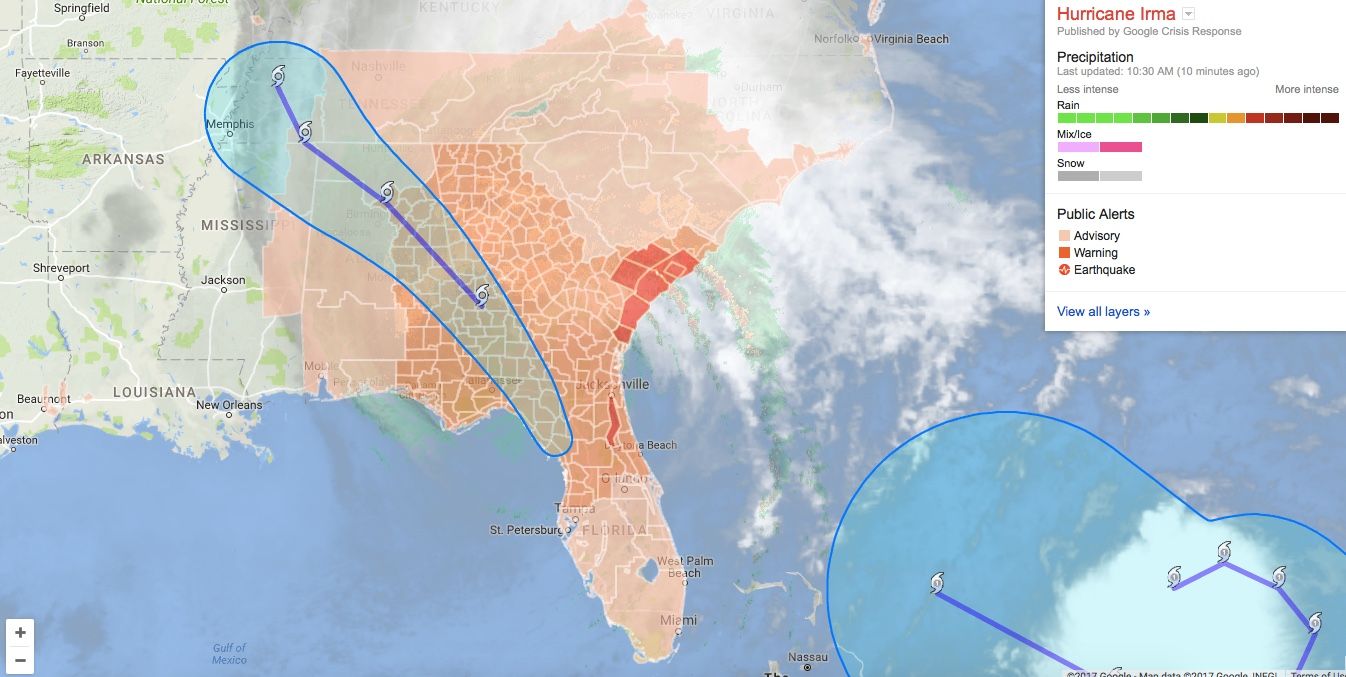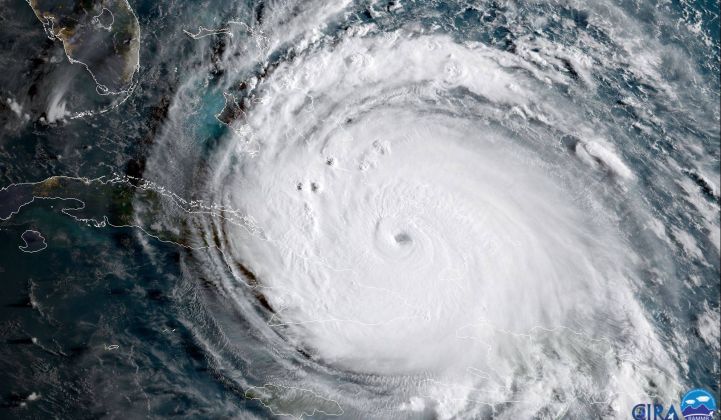Hurricane Irma has left millions people without electricity, as winds, rain and storm surges have brought down grid infrastructure across Florida and Georgia. With the storm still thrashing its way inland toward Alabama and the Carolinas, utilities are stuck waiting for safer conditions to assess the damage, before they can even begin to work on what is “likely to be one of the largest industry restoration efforts in U.S. history."
That’s how the Edison Electric Institute (EEI) trade group described the challenge facing utilities in the days and weeks to come. As of Monday morning, more than 6.1 million utility customers were without power in Florida, Georgia and South Carolina, it reported.
In response, more than 50,000 workers from the U.S. and Canada have assembled at staging areas across the affected states, EEI wrote. But they face the same downed trees, washed-out bridges and roads, and coastal storm surges and flooding that are preventing emergency responders from getting to the worst-hit areas.
Even after the storm passes, parts of the grid will “need to be rebuilt completely before power can be restored,” EEI warned. “This will delay restoration times, and customers should be prepared for the possibility of extended power outages.”
Florida has been the hardest hit by Hurricane Irma, with nearly every county reporting outages of at least 20 percent as of Monday, according to data from the state Office of Emergency Management. In some coastal counties the outage rates are as high as 97 percent.

Florida Power & Light (FPL), the state’s biggest utility, had more than 3.4 million of its 10 million customers without power as of Monday morning, leaving nearly 7 million people in the dark. While the utility has restored about 400,000 customers since the storm hit, many more could be waiting “multi-weeks” for power to be restored, CEO Eric Silagy said in a press conference.
Southern Florida has been the hardest hit by Irma. In Miami-Dade County, 815,650 customers are without power, which represents just under 80 percent of FPL’s residential and business accounts, the Sun-Sentinel reported. Palm Beach County has 523,540 customers without power, or 70 percent of its accounts, and Broward County had 643,890 outages, or 68 percent of its accounts.
Hurricane Irma’s winds have torn construction cranes in half and leveled buildings across a stretch of coastline from the Florida Keys to the Georgia Sea Islands, along with the Gulf Coast from Tampa and Tallahassee. FPL lost power at its Riviera Center command center on Sunday -- in the midst of a press conference -- and was relying on backup generators on Monday.
Southern Company subsidiary Georgia Power had more than 410,000 customers without power as of Monday morning. Like FPL, it reported that “in some cases, these could be long-duration outages, particularly if energy infrastructure must be rebuilt before power can be restored.”
Irma was downgraded to a tropical storm on Monday, but is still expected to bring damaging winds and flooding rain as it passes across Georgia toward Alabama and Carolinas. On the coasts, storm surges and flooding remain a threat -- much of Jacksonville, Fla. was underwater on Monday in the midst of record-high flooding.
Georgia Power said it must “wait until conditions are safe for damage assessment teams to enter the field and begin the restoration process.” The utility has about 3,400 employees working on restoring the outages. But with “widespread, extensive damage” from the hurricane’s wind and rain, the assessment and restoration process could take “several days, if not weeks, depending on the amount of damage and safe access to the area,” as noted on the utility’s outage and storm center website.
FPL has about 17,000 utility workers ready to help its restoration efforts, which could be significant. Ed DeVarona, senior director of emergency preparedness, told USA Today that the utility expects it may need to rebuild much of its Gulf Coast infrastructure, from downed poles and transformers to entire substations.
FPL, a subsidiary of NextEra Energy, has been preparing for future storms as part of its $3 billion grid infrastructure investment program, which included more concrete poles to replace wooden ones, flood monitoring for low-lying substations, and smart meters that can, among other things, report outages. But Silagy told Bloomberg on Friday that Hurricane Irma brought winds that could “snap a concrete pole” and overwhelm flood protections for underground distribution systems.
“We have the strongest, most highly engineered, smartest grid in the U.S., but there is no way to engineer against a storm of this kind of magnitude," he said.
FPL’s website lays out its priorities for restoring power, starting with its own power plants, substations and damaged transmission lines. Next come “critical facilities such as hospitals, police and fire stations, communication facilities, water treatment plants and transportation providers.” The utility also looks to prioritize restoring electricity service to ”the largest number of customers in the shortest amount of time -- including service to major thoroughfares that host supermarkets, pharmacies, gas stations and other needed community services.”

As of Monday, the state’s generation fleet had remained up and running as normal, with the exception of two FPL nuclear power plants directly in Irma’s path. FPL’s Turkey Point plant shut down one of its reactors on Thursday, but kept the other running. The St. Lucie plant kept both of its units running for the duration, although the Nuclear Regulatory Commission reported Monday that Unit 1 was reducing power output to deal with salt buildup -- likely from wind-blown seawater -- on insulators in the switchyard that supplies its offsite power.
Georgia Power reported no problems with its power plants, including its Vogtle and Hatch nuclear power plants, which it noted “are designed to withstand significant hazard events, including hurricane force winds and flooding.”



